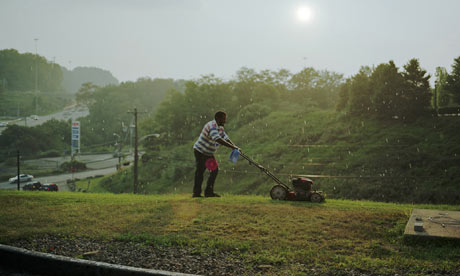
Continuing her series on photography books, Liz looks at a catalogue offering a closeup of Robert Frank's The Americans, while she reviews British photographer Paul Graham's long overdue retrospective volume

Pittsburgh (Man Cutting Grass), 2004 (30 x 40", 76.2 x 101.6 cm). One of nine pigmented inkjet prints, from A shimmer of possibility, Photographs by Paul Graham, MoMA, New York © 2009 Paul Graham
On 25 January, it will be 170 years since photography was invented. Considering its influence, that doesn't seem like a very long time. From photographs came first cinema, then magazines, advertising, television and, by extension, the promotion of goods and people that drives consumerism and celebrity. It has brought all kinds of good things, too: bodies of scientific, medical, criminal, judicial and military evidence, and the identification and visual classification of people, plants, machines, houses, birth, death and everything in between. Its so-called democracy can be a curse as well as a blessing, but – though one can try – it's almost impossible to imagine a world in which some sort of photographic image doesn't exist.
The technologies of photography and printing might have changed beyond recognition in 170 years, but the photographic book is still essentially the same: a series of pictures with or without a written commentary. Last year's big photobook celebration was the 50th anniversary of Robert Frank's The Americans, which was first published in France. The German publishing house Steidl embarked on a programme of reissuing all of Frank's books and films. This year, the anniversary celebrations continue, since the US edition of The Americans – the one with the famous introduction by Jack Kerouac, describing how Frank "sucked a sad poem right out of America onto film" – was actually published in 1959. Later this month, the National Gallery of Art in Washington, which holds Frank's archive, opens a new exhibition, Looking In: Robert Frank's The Americans. The show will examine Frank's background, influences, contact sheets and photo selections, and will include essays and commentaries – everything, in fact, you might wish to know. The catalogue will be published in a soft-cover edition (£28) and an expanded hardback (£47). The show opens on 18 January and travels to San Francisco's Museum of Modern Art in May and the Metropolitan Museum of Art in New York in September.
The British photographer Paul Graham has two major exhibitions this year: a 25-year retrospective that opens at the Folkwang Museum in Essen in January (and comes to the Whitechapel Gallery in London in 2011) and a show of recent work at the Museum of Modern Art in New York, which opens in February. This means the publication of the first retrospective book of Graham's work (SteidlMACK, £40), including his early projects A1 – The Great North Road (1981-2) and Beyond Caring (1984), a study of unemployment offices in Britain. At the beginning of the 1980s, Graham radically altered both the language and effect of social documentary photography when he chose colour rather than black-and-white. It had an immediate, galvanising effect, returning to reality what had become a nostalgic cipher for social commentary.
Since then, Graham has continued to explore the potential of colour in making new kinds of documentary pictures. The New York show is based on his most recent series, published last year under the title The Shimmer of Possibility. Graham records short sequences of mundane incidents: a man walks across a stretch of waste ground past a ginger cat; a man mows a grass verge in the rain; a couple carry their shopping home from the supermarket; an overweight man in a patterned shirt leans against a wall and smokes a cigarette; a man clutches his head on a New York street. Often several stories are intercut within one volume; sometimes there is a dominant single image, sometimes not. Graham's camera acts as a framing device, but in each case we feel the presence of the photographer as a voyeur, observing the non-dramas of other people's lives. The people in these pictures are mostly poor, often black, always vulnerable. This is the class that lives on the street, shops in mini-markets, travels by bus and still (perhaps most revealingly) relies on public telephones. The middle classes are symbolised by large, immaculate, detached houses, large shiny saloons and SUVs, all equally fortified against attack.
Jim Goldberg has worked in America for most of his career, and has never settled into any definable category. In his early books, such as Rich and Poor (1977-85) and Raised By Wolves (1995), which told the story of a couple of homeless teenagers in Los Angeles, his subjects were involved in telling their own stories, creating a new style of collaborative photo-documentary. In 2007 Goldberg received the Henri Cartier-Bresson Foundation award, which enables a photographer to carry out a difficult project he or she would otherwise be unable to complete. The result is a new book, Open See (Steidl/FHCB Paris, £30), which began as a project in Greece in 2004, and tells stories of social, economic and political migration, in which people from countries including Iraq, Nigeria, Somalia, China, Congo, Poland, Afghanistan and Albania try to make a new life in Europe.
 Following the ground broken by Martin Parr and Gerry Badger in their two-part history of the photobook (Phaidon), June sees the publication by Aperture of Japanese Photobooks of the 1960s and 70s (£40) (see also ...). Until recently, this period of Japanese publishing, although favoured by collectors, has been overlooked by the main photography presses. This book explores an era in which standards of photography, printing and bookmaking came together to produce works of high quality. In February, Martin Parr continues his own list of commissioned titles for the Nazraeli Press with the Dutch photographer Raimond Wouda's School ($60), a study of the communal areas in which schoolchildren meet and interact. Also in February, Phaidon is publishing a complete set of American photographer Danny Lyon's photo essays, with accompanying text, entitled Memories of Myself (£45). Lyon is famous for documentary books including the Bike Riders (1967), a record of his time riding with the Chicago Outlaws, and Conversations with the Dead (1971), which focused on the Texas penal system. At the end of April, the British photographer Chris Killip's first book of colour photographs, Here Comes Everybody: Chris Killip's Irish Photographs, is published by Thames & Hudson (£29.95).
Following the ground broken by Martin Parr and Gerry Badger in their two-part history of the photobook (Phaidon), June sees the publication by Aperture of Japanese Photobooks of the 1960s and 70s (£40) (see also ...). Until recently, this period of Japanese publishing, although favoured by collectors, has been overlooked by the main photography presses. This book explores an era in which standards of photography, printing and bookmaking came together to produce works of high quality. In February, Martin Parr continues his own list of commissioned titles for the Nazraeli Press with the Dutch photographer Raimond Wouda's School ($60), a study of the communal areas in which schoolchildren meet and interact. Also in February, Phaidon is publishing a complete set of American photographer Danny Lyon's photo essays, with accompanying text, entitled Memories of Myself (£45). Lyon is famous for documentary books including the Bike Riders (1967), a record of his time riding with the Chicago Outlaws, and Conversations with the Dead (1971), which focused on the Texas penal system. At the end of April, the British photographer Chris Killip's first book of colour photographs, Here Comes Everybody: Chris Killip's Irish Photographs, is published by Thames & Hudson (£29.95). Yale University Press continues to publish fine works in association with the Yale University Art Gallery. In preparation for a touring show that opens in 2010, two new editions of books by the American photographer Robert Adams are published in July. Denver (£30), first published in 1977, and What We Bought (£35), first published in 1995, form a trilogy with The New West, probably Adams's most famous book. All three examine the reckless suburban sprawl of cities such as Denver, Phoenix and Salt Lake City, which have depleted the surrounding natural resources as they have grown.
Finally, the French historian François Brunet is the author of Photography and Literature (£15.95), the latest in the Reaktion Books series on photography, commissioned by Mark Haworth-Booth, former curator of photographs at the V&A. Brunet examines the traditionally unequal relationship between writing and photographs, where literature's perceived depth has always given it the upper hand. He suggests that this is changing, and uses examples from fiction, non-fiction and critical writing, as well as photographs, to prove a growing interdependence.
See for more ... 















Geen opmerkingen:
Een reactie posten